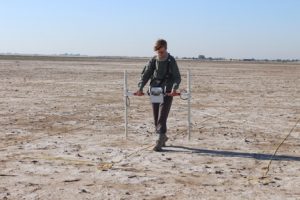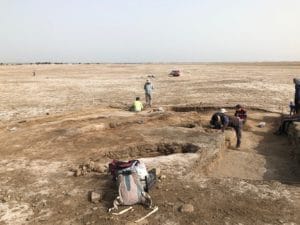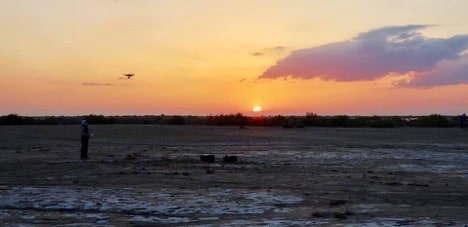
A RETURN TO ANCIENT LAGASH
Avary Taylor, 2019 P. E. MacAllister Excavation Fellowship Recipient

Avary Taylor collecting geophysical data with Bartington magnetometer.
The P. E. MacAllister Excavation Fellowship financially supported my travel to the site of al-Hiba, Iraq (ancient Lagash) in March and April of 2019 to take part in the Lagash Archaeological Project (LAP). The team—composed of faculty, researchers, and graduate students from the University of Pennsylvania, the University of Cambridge, the Università di Pisa, and the State Board of Antiquities and Heritage of Iraq, as well as myself, a fifth-year PhD candidate in the Near Eastern Studies Department at Johns Hopkins University—surveyed and excavated the site, which had not been revisited since 1990.
Tell al-Hiba is located in the Dhi Qar Province of southern Iraq. The site was briefly excavated by Robert Koldewey in 1887, but it was not until six campaigns led by teams from the Metropolitan Museum of Art and the Institute of Fine Arts of New York University undertaken in the mid- and late-twentieth century that the importance of the site was fully realized. Lagash was one of the earliest cities in the world and was a dominating power in Sumer during the third millennium BCE. The third millennium is characterized by major cultural and political changes. During the Early Dynastic Period, which is named after the earliest evidence for dynastic rule in Mesopotamia, dynastic kings ruled over city-states that emerged in southern Iraq and shared a common, Sumerian identity. Al-Hiba is a significant site in the study of early urbanism in the ancient world. During this period, the city of Lagash grew as large as 600 hectares and competed with other Sumerian city-states.

Area H photograph with excavated kilns immediately below surface.
The 2019 field season at al-Hiba was highly successful and produced many exciting finds, including evidence of a monumental city wall and a royal cone of king Enmetena. The season was focused around surface collection surveys, remote sensing (drone photography and geophysics surveys), and excavations in Area G, a previously opened area with extensive Early Dynastic I levels and a monumental curving wall, and the newly opened Area H, an industrial zone.
My time at Lagash was spent excavating, collecting geophysical data with a magnetometer, and cataloging and analyzing ceramics. I proudly was able to beat many personal bests on the magnetometer, and the team successfully covered a truly massive area of the site during survey and remote sensing. After excavating during the day, I would help catalogue ceramics and I became intimately familiar with the hundreds of beaker sherds that the team excavated this season.
During the team’s days off, we were able to travel to neighboring southern Iraq sites, such as Tell al-Muqayyar (ancient Ur), where we were fortunate enough to experience a massive dust storm immediately followed by a rain storm. Despite how it may sound, this was truly a special experience; pictures of the site, and particularly of the ziggurat, are captured on bright, sunny days. Experiencing the site in more extreme weather provided me with an important alternative view of Ur than many scholars have access to. The team was also able to visit the newly opened Basra Museum, which housed many wonderful Mesopotamian objects within its beautiful building.

Drone flying above sunset landscape of Lagash.
Avary Taylor is a PhD candidate in Near Eastern Studies at Johns Hopkins University. Taylor is an art historian who specializes in the art of the Neo-Assyrian Period. His in-progress dissertation, “The ‘Thing’ About the Palace: A Posthumanist Biography of the Northwest Palace,” seeks to understand the life of a Neo-Assyrian palace, not as a constructed result reflecting human agency and will, but as an autonomous being itself. The dissertation engages with posthumanist theories to explore the proposition that the role of humans is secondary to the “thing.” Taylor is also involved in several archaeological projects in addition to al-Hiba, such as Kurd Qaburstan (Johns Hopkins University).
American Society of Overseas Research
The James F. Strange Center
209 Commerce Street
Alexandria, VA 22314
E-mail: info@asor.org
© 2023 ASOR
All rights reserved.
Images licensed under a Creative Commons Attribution-NonCommercial-ShareAlike 4.0 International License
COVID-19 Update: Please consider making payments or gifts on our secure Online Portal. Please e-mail info@asor.org if you have questions or need help.